

Un questionnaire contre les articles scientifiques bidons à l’usage de l’internaute naïf. ControverSciences.org. [Bogucka2015] How to Read Scientific Research Articles. How to Read Scientific Research Articles: A Hands-On Classroom Exercise Roxanne Bogucka Science Instruction Librarian University of Texas Austin, Texas Emily Wood Reference/Instruction Librarian Pierce College Fort Steilacoom Lakewood, Washington Abstract Undergraduate students are generally unfamiliar with scientific literature.
![[Bogucka2015] How to Read Scientific Research Articles](http://cdn.pearltrees.com/s/pic/th/scientific-research-articles-114007521)
Introduction In the fall semester of 2007, Roxanne started teaching three library instruction sessions for an upper-division nutritional sciences course with a significant writing component. The instructor wanted students to learn how to search PubMed, how to read and evaluate the articles they found in their searches, and how to cite these articles, preferably via hands-on exercises. It was easy enough to conceive what a hands-on session on PubMed or EndNoteTM would look like, but creating a how-to-read exercise took more investigation. Materials Needed We supplied note-taking forms for the students. Description. Îlot de rationalité - accueil. Adoptant une perspective socioconstructiviste de la construction des savoirs savants, de l'enseignement et de l'apprentissage, nous avons élaboré un outil didactique qui s'adresse à des enseignants du niveau collégial – de toutes disciplines – et qui, par son approche interdisciplinaire, permet l'atteinte de plusieurs des finalités des programmes collégiaux.
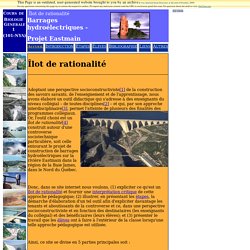
Or, l'outil choisi est un îlot de rationalité construit autour d'une controverse sociotechnique particulière, soit celle entourant le projet de construction de barrages hydroélectriques sur la rivière Eastmain dans la région de la Baie James, dans le Nord du Québec. Ainsi, ce site se divise en 5 parties principales soit : GROLEAU (2013). "Qu'est-ce que l’îlot de rationalité interdisciplinaire et pourquoi s'y intéresser?". Spectre, Février 2013. How scientists are annotating climate reporting - Columbia Journalism Review. When melting ice disappears from the arctic, it exposes more of the ocean’s dark surface, which absorbs the sun’s warming rays.
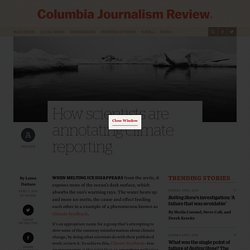
The water heats up and more ice melts, the cause and effect feeding each other in a example of a phenomenon known as climate feedback. It’s an appropriate name for a group that’s attempting to slow some of the runaway misinformation about climate change, by doing what scientists do with their published work: review it. To achieve this, Climate Feedback—less an organization at this point than an amorphous gathering of climate scientists, oceanographers, and atmosperic physicists—is making use of a browser plugin from the nonprofit Hypothes.is to annotate climate journalism on the Web. Readers with the plugin, or with a link created through it, can read an article while simultaneously reading comments and citations from a cadre of experts. About 25 scientists are listed as contributors, and more can apply as long as they’re actively publishing climate research. Bruno Latour : description de Controverses (Cours, Mines-ParisTech)
Outils pour la cartographie des controverse. How can you tell if scientific evidence is strong or weak? - 8 ways to be a more savvy science reader. The most reliable type of study — especially for clinical trials — is the randomized, placebo-controlled, double-blind study.
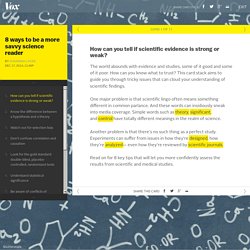
If you are looking at a clinical trial, a psychology study, or an animal study, and it hasn't been designed like this — and there isn't a good reason that it couldn't have been — then you might want to question the results. Let's break down this terminology: 1) Randomized: This means that the participants in the study were randomly placed into the experimental group and the comparison group.
This is important because if people get to choose, they might be more likely to pick one or the other because of some unexpected factor. As a hypothetical example, maybe people who are more optimistic are more likely to want to try a new drug for anxiety rather than an old drug that's being used for comparison. Similar problems can be introduced if researchers choose who goes into which category. A good placebo group should be as similar to the experimental group as possible. A Rough Guide to Spotting Bad Science.
A Rough Guide to Spotting Bad Science Click to enlarge A brief detour from chemistry, branching out into science in general today.
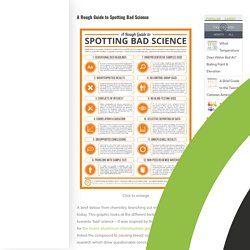
This graphic looks at the different factors that can contribute towards ‘bad’ science – it was inspired by the research I carried out for the recent aluminium chlorohydrate graphic, where many articles linked the compound to causing breast cancer, referencing scientific research which drew questionable conclusions from their results. The vast majority of people will get their science news from online news site articles, and rarely delve into the research that the article is based on. Personally, I think it’s therefore important that people are capable of spotting bad scientific methods, or realising when articles are being economical with the conclusions drawn from research, and that’s what this graphic aims to do.
EDIT: Updated to version 2! École de technologie supérieure (2015). "Dix éléments pour augmenter la visibilité de vos publications" Le mercredi 1 avril 2015 Les indicateurs de production scientifique calculés à partir du nombre d'articles publiés et du nombre de citations reçues ont une influence sur de nombreux aspects de la carrière d'un chercheur.
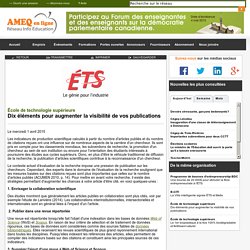
Ils sont pris en compte pour les classements mondiaux, les subventions de recherche, la promotion d'un chercheur au sein de son institution ou encore pour l'orientation des étudiants intéressés à poursuivre des études aux cycles supérieurs.